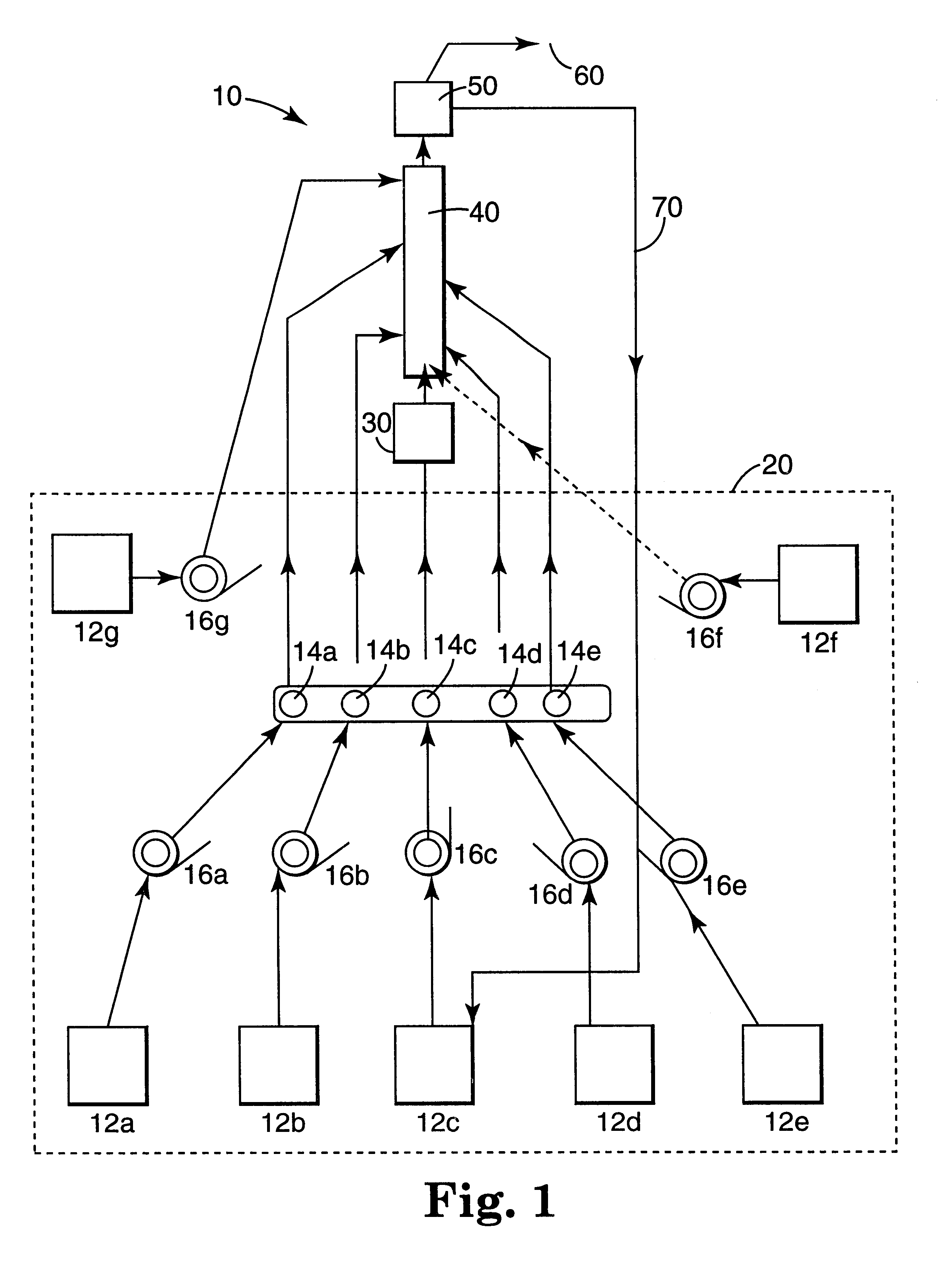Continuous process for the production of controlled architecture materials
a technology of controlled architecture and continuous process, which is applied in the direction of chemical/physical/physical-chemical processes, chemical apparatus and processes, chemical/physical/physical-chemical stationary reactors, etc., can solve the problems of complex anionic polymerization methods for the production of block copolymers containing polar monomers, and the inability to maintain temperature control and flow in a essentially plug-flow manner
- Summary
- Abstract
- Description
- Claims
- Application Information
AI Technical Summary
Benefits of technology
Problems solved by technology
Method used
Image
Examples
example 1
Poly(styrene-4-vinyl pyridine) Block Copolymer
This example illustrates the effect of the continuous process on properties of polymers made as different times.
An initiator slurry was prepared by mixing 1884.6 ml of 1.3 M sec-butyl lithium solution in 4823.8 g of O.sub.2 -free toluene and continuous stirring at room temperature for about 30 minutes. The stirring was done under N.sub.2 to prevent stratification and oxygen contamination. Purified styrene monomer (pressure fed at a rate of 136.1 g / min) and purified toluene solvent (diaphragm pumped at a rate of 154.9 g / min) were fed into the STR. The initiator slurry was introduced by peristaltic pump at a rate of 19.6 ml / min into zone 1 of the STR. The monomer concentration of this reaction was 44 wt. % in styrene monomer. A color change, from clear to red-orange, was observed in zone 1 when the initiator solution contacted the monomer and an exotherm resulted. The mixture in zone 1 was kept constant at about 65.degree. C. by adjusting ...
example 2
xample 1 except some process conditions were changed. An initiator slurry was prepared by mixing 753 ml of 1.3 M sec-butyl lithium solution in 4853 g of O.sub.2 -free cyclohexane and continuous stirring at room temperature for about 30 minutes. The stirring was done under N.sub.2 to prevent stratification and oxygen contamination. Purified styrene monomer (pressure fed at a rate of 65.3 g / min) and purified cyclohexane solvent (diaphragm pumped at a rate of 134.3 g / min) were fed into the STR. The initiator slurry was introduced by peristaltic pump at a rate of 23.3 ml / min into zone 1 of the STR. The monomer concentration of this reaction was 31 wt. % in total monomers. The temperatures in zones 1 and 2 were the same as in Example 1. The temperatures in zone 3, zone 4 and zone 5 were maintained at 25.degree. C., 20.degree. C. and 20.degree. C., respectively. Vinyl pyridine (989.23 g) was premixed with cyclohexane (3970 g) in a 2 gallon pressure can and pressure fed to the reactor afte...
example 3
manner similar to Example 1 except some process conditions were changed. An initiator slurry was prepared by mixing 1200 ml of 1.3 M sec-butyl lithium solution in 2665 g of O.sub.2 -free toluene and continuous stirring at room temperature for about 30 minutes. The stirring was done under N.sub.2 to prevent stratification and oxygen contamination. Purified styrene monomer (pressure fed at a rate of 130.0 g / min) and purified toluene solvent (diaphragm pumped at a rate of 165.8 g / min) were fed into the STR. The initiator slurry was introduced by peristaltic pump at a rate of 14.6 ml / min into zone 1 of the STR. At the start of zone 4, purified vinyl pyridine was added (pressure fed at a rate of 6.6 g / min) to the "living" polystyrene reaction mixture. The monomer concentration of this reaction was 42 wt. % in total monomers.
For Samples A to D, the temperatures in zones 1, 2, 3 and 5 were the same as in Example 1 and the temperature in zone 4 was maintained at 20.degree. C., 30.degree. C....
PUM
| Property | Measurement | Unit |
|---|---|---|
| Angle | aaaaa | aaaaa |
| Percent by mass | aaaaa | aaaaa |
| Fraction | aaaaa | aaaaa |
Abstract
Description
Claims
Application Information
 Login to View More
Login to View More - R&D
- Intellectual Property
- Life Sciences
- Materials
- Tech Scout
- Unparalleled Data Quality
- Higher Quality Content
- 60% Fewer Hallucinations
Browse by: Latest US Patents, China's latest patents, Technical Efficacy Thesaurus, Application Domain, Technology Topic, Popular Technical Reports.
© 2025 PatSnap. All rights reserved.Legal|Privacy policy|Modern Slavery Act Transparency Statement|Sitemap|About US| Contact US: help@patsnap.com

